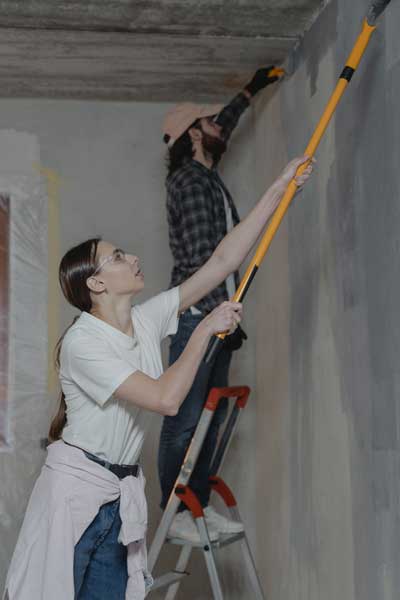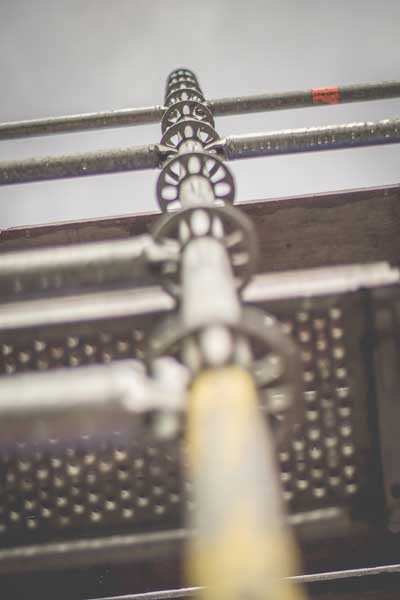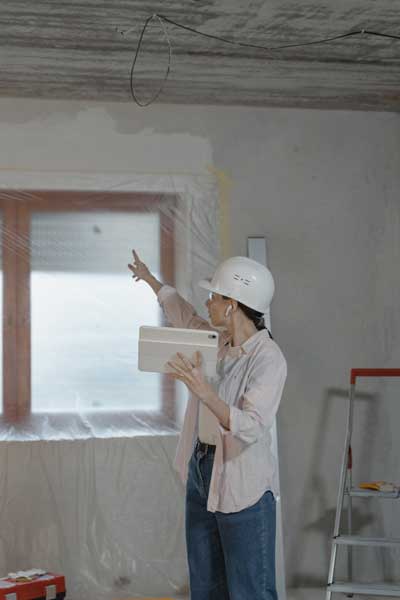Working at heights

Working at height remains one of the biggest causes of fatalities and serious injuries across the UK. The main causes include falls from ladders and through fragile surfaces. It is also the most significant commonly identified hazard in many Church of Scotland buildings and has resulted in a number of serious injuries and even fatalities.
Historic stairways, fixed and loose ladders and the lack of guardrails and unprotected edges at height will continue to be a significant hazard for many church buildings constructed before modern building regulations. The historic aesthetics of the buildings and any inherent hazards that are difficult to control need to be suitably risk assessed. Any access at height into the roof spaces, clocktowers and spires should be restricted and closely monitored. Only contractors, employees and volunteers that are competent and have undergone specific working at height training should be permitted access to these areas with the relevant safety equipment and PPE required for the task.
The General Trustees can provide further site-specific advice and guidance on sympathetic measures with consideration to the listed building consent for any additional or retro-fitted safety measures and mitigations that may be required to further ensure safety in these types of building-specific hazards.
Control measures

The Work at Height Regulations (2005) set out a hierarchy of measures which must be considered when carrying out a risk assessment for any work activity involving working at height. Preference must be given to the first measure of the hierarchy, only moving down the list if each measure is not reasonably practicable.
The hierarchy of control measures, from most preferable to least preferable:
- Avoid carrying out work at height (for example, using long-handled tools to clean windows or trim hedges)
- Use existing safe places of work or means of access or egress (for example, fixed platforms or stairways)
- Use adequate work equipment to prevent a fall (for example, scaffolding, scaffold tower, mobile elevating platforms)
- Minimise the distance and/or consequences of a fall (for example, using fall arrest equipment such as harnesses, safety nets or air bags)
Historical access
Any historically formed and non-regulatory fixed or loose ladders and formed staircases and access to heightened unprotected edges within the buildings should be suitably risk assessed and made safe or restricted from use. Further advice and guidance on controlling or eliminating these hazards for employees, volunteers and contractors is available from the General Trustees health and safety department.
Practical considerations
In general, staff and volunteers should not be involved with any activities that require working at height. However, a complete blanket ban on all working at height activities is impracticable and disproportionate and we therefore recommend that low-risk work involving the use of small ladders and stepladders can be carried out safely as long as the principles discussed in this toolkit are considered and followed.
It is essential that Charity Trustees of congregations recognise the significant health and safety risks that working at height has for employees, volunteers, members of the public and contractors working in the church premises.
The Work at Height Regulations (2005)
The Work at Height Regulations (2005) are very prescriptive and require employers, the self-employed and any person who controls the work of others to appropriately assess and adequately control any work undertaken at height. The Charity Trustees must ensure that employees, volunteers and contractors that carry out any work or activities at height are “as safe as is reasonably practicable”.
The regulations require that:
- All work at height must be properly planned, organised and supervised and carried out in a way that is, as far as reasonably practicable, safe. Planning must include the appropriate selection of equipment to be used and procedures for emergencies and rescue. Consideration must also be given to the working environment and, in particular, the weather.
- Anyone involved with planning, organising, supervising, arranging equipment and working at height must be competent to do so
- The risk assessment for working at height is suitable and sufficient and appropriate work equipment (including PPE) is used. For routine working at height activities such as gutter cleaning, visual inspections, tree pruning and light bulb replacements etc, providing a prescriptive safe system of work (SSOW) for these activities along with the risk assessment will ensure that that employees and volunteers have a safety framework to ensure that they can safely carry out the task or activity (See risk assessment section).
- Special consideration must be given to working on or near fragile roofs or surfaces. It is necessary to ensure that nobody passes across or near, or works from or near, a fragile surface unless it is reasonably practicable to do so under appropriate conditions. If it is not reasonably practicable to do so, suitable and sufficient platforms, coverings, guardrails or similar means of support must be provided and used. In addition, suitable and sufficient measures must be taken to minimise the distances and consequences of a fall.
- If there are any fragile roofs or surfaces within any congregation properties, prominent warning notices must be affixed at the approach to these so that people are aware of the risks of working on or near the area
- All equipment for working at height must be properly inspected and maintained
- Suitable precautions are in place to prevent injury from falling objects when working at height. This might involve stopping people accessing areas underneath until the work is complete.
Training
Anyone required to undertake any work at height must be appropriately trained. The training must include use of any equipment required to undertake the job and method of undertaking the job safely.
It is also important to consider individual capabilities for working at height. Employees and anyone else required to work at height must report any issues (including health issues) which might affect their ability to undertake their work safely. For example, if someone suffers from recurring dizziness, epilepsy, a heart condition or severely impaired joint function, he or she should not be allowed to work at height.
Use of ladders and stepladders

Ladders and stepladders can be useful pieces of equipment in any congregation building if they are used safely for light work of short duration. It is important to consider the task, person and working environment before any task is carried out, as well as to ensure that ladders and stepladders are fit for purpose – checked before and after use for damage and only used following the manufacturers' instructions. Any aged wooden ladders and damaged access equipment that is not considered to meet the current British Safety Standards should be suitably discarded or recycled to prevent its use.
The HSE has produced a number of excellent resources on the safe use of ladders and stepladders, including an employer’s guide. This is available online or through the Church of Scotland General Trustees.
Use of mobile platforms or scaffold towers

We are aware that some congregations have purchased their own mobile platforms or scaffold towers, which they erect, use and dismantle on their own premises to carry out work at height. It is important that the Charity Trustees are fully aware of the risk and potential health and safety implications of working at height and have sufficient information to make an informed choice before allowing the use of such equipment in their buildings.
Such equipment must be fit for purpose and anyone using it must be competent and fully trained. It is likely that mobile platforms and scaffold towers will require annual inspection and maintenance (not including the regular checks undertaken by the congregation) to ensure that they are safe to use. However, the Church of Scotland recommends that such equipment is not purchased and used by congregations, and that any high-level work requiring its use should be undertaken by a suitably qualified external contractor that can demonstrate professional competency, relevant public liability and professional indemnity insurance cover for its use and that of their employees.
What does 'working at height' mean?

Working at height means working in any place where, if precautions are not taken, a person could fall a distance, resulting in personal injury. You are working at height if you:
- Work above ground-floor level
- Could fall from an edge, through an opening or fragile surface
- Could fall from ground level into an opening in a floor or a hole in the ground
Working at height does not include a slip or a trip on the level – a fall from height has to involve a fall from one level to a lower level. It does not include walking up and down a permanent staircase in a building.
Working at height risk assessment

As already highlighted, a suitable and sufficient risk assessment must be carried out for any work involving working at height. The risk assessment must demonstrate that the work being carried out is:
- Planned
- Organised
- Carried out by a competent person
- Following the hierarchy for managing risks from working at height – reasonable steps must be taken to avoid, prevent or reduce the risk of harm occurring
- Carried out using the most appropriate work equipment
- Undertaken using appropriate collective measures to prevent falls (such as guardrails and working platforms) before other measures which only mitigate the distance and consequences of a fall (such as nets and airbags) or which might only provide personal protection from a fall.